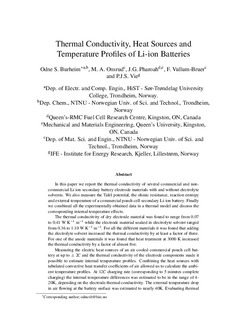| dc.contributor.author | Burheim, Odne Stokke | |
| dc.contributor.author | Onsrud, Morten Andreas | |
| dc.contributor.author | Pharoah, John George | |
| dc.contributor.author | Vullum-Bruer, Fride | |
| dc.contributor.author | Vie, Preben Joakim Svela | |
| dc.date.accessioned | 2017-09-04T06:20:04Z | |
| dc.date.available | 2017-09-04T06:20:04Z | |
| dc.date.created | 2014-09-11T13:38:51Z | |
| dc.date.issued | 2014 | |
| dc.identifier.citation | ECS Transactions. 2014, 58 (48), 145-171. | nb_NO |
| dc.identifier.issn | 1938-5862 | |
| dc.identifier.uri | http://hdl.handle.net/11250/2452876 | |
| dc.description.abstract | In this paper we report the thermal conductivity of several commercial and non-commercial Li-ion secondary battery electrode materials with and without electrolytesolvents. We also measure the Tafel potential, the ohmic resistance, reaction entropyand external temperature of a commercial pouch cell secondary Li-ion battery. Finallywe combined all the experimentally obtained data in a thermal model and discuss thecorresponding internal temperature effects.The thermal conductivity of dry electrode material was found to range from 0.07to 0.41 WK−1m−1 while the electrode material soaked in electrolyte solvent rangedfrom 0.36 to 1.10 WK−1m−1. For all the different materials it was found that addingthe electrolyte solvent increased the thermal conductivity by at least a factor of three. For one of the anode materials it was found that heat treatment at 3000 K increasedthe thermal conductivity by a factor of almost five.Measuring the electric heat sources of an air cooled commercial pouch cell bat-tery at up to ± 2C and the thermal conductivity of the electrode components madeit possible to estimate internal temperature profiles. Combining the heat sources withtabulated convective heat transfer coefficients of air allowed us to calculate the ambi-ent temperature profiles. At 12C charging rate (corresponding to 5 minutes completecharging) the internal temperature differences was estimated to be in the range of 4-20K, depending on the electrode thermal conductivity. The external temperature dropin air flowing at the battery surface was estimated to nearly 40K. Evaluating thermal management of batteries in the light of our measurement led to the conclusion that ex-ternal cooling is more challenging than internal, though neither should be neglected. | nb_NO |
| dc.language.iso | eng | nb_NO |
| dc.publisher | Electrochemical Society | nb_NO |
| dc.title | Thermal Conductivity, Heat Sources and Temperature Profiles of Li-ion Batteries | nb_NO |
| dc.type | Journal article | nb_NO |
| dc.type | Peer reviewed | nb_NO |
| dc.description.version | acceptedVersion | nb_NO |
| dc.source.pagenumber | 145-171 | nb_NO |
| dc.source.volume | 58 | nb_NO |
| dc.source.journal | ECS Transactions | nb_NO |
| dc.source.issue | 48 | nb_NO |
| dc.identifier.doi | 10.1149/05848.0145ecst | |
| dc.identifier.cristin | 1153670 | |
| dc.relation.project | Norges forskningsråd: 228739 | nb_NO |
| dc.description.localcode | © 2014 ECS - The Electrochemical Society. This is the authors' accepted and refereed manuscript to the article. | nb_NO |
| cristin.unitcode | 194,68,20,40 | |
| cristin.unitcode | 194,66,25,0 | |
| cristin.unitcode | 194,66,35,0 | |
| cristin.unitname | Institutt for elektrofag og fornybar energi | |
| cristin.unitname | Institutt for kjemi | |
| cristin.unitname | Institutt for materialteknologi | |
| cristin.ispublished | true | |
| cristin.fulltext | postprint | |
| cristin.qualitycode | 1 | |
